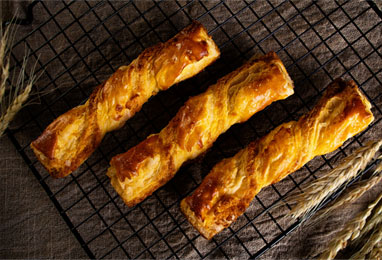Properties and applications of maltitol in food
The chemical name of maltitol is 4-0-aD-glucosyl-D-glutol, molecular formula: C12H24O1 , molecular weight 344.37, and its appearance is white crystalline powder or colorless and transparent neutral viscous liquid, easily soluble In solvents such as water and ethanol, the viscosity is moderate. The melting point of crystal form is 148~151°C. The sweetness is 0.8-0.9 times that of sucrose. The sweetness of liquid form is 0.6 times that of sucrose. Its sweetness is soft and delicious, with no aftertaste.
Physical and chemical properties of maltitol
Stability: Pure maltitol is a colorless and transparent crystal, which is very stable to heat and acid. Since there are no free hydroxyl groups in the maltitol structure, Maillard reaction will not occur during food processing, even with amino acids and proteins. Heating does not cause Maillard reaction.
Solubility: Maltitol is easily soluble in water, 0.1 mol/L NaOH and 0.1 mol/L HCl, insoluble in methanol and ethanol, and insoluble in chloroform and ethyl acetate; liquid maltitol has greater solubility in water than crystalline maltitol; The solubility of maltitol in ethanol aqueous solution decreases with the increase of ethanol concentration.
Sweetness: The sweetness of maltitol is 80% to 90% of that of sucrose. Its sweetness characteristics are close to that of sucrose. It has a soft flavor and no irritating or sour aftertaste.
Hygroscopicity and moisturizing properties: Liquid maltitol absorbs and releases moisture smoothly, and has good moisturizing properties. Powdered maltitol can absorb 3% to 5% moisture, but is still a powder, while maltitol crystals with high purity are not hygroscopic at all. .
Viscosity: The viscosity of maltitol aqueous solution is lower than that of sucrose or sucrose-glucose aqueous solution, which will affect the rheological properties of food materials during processing. During the hard candy manufacturing process, the molding temperature needs to be appropriately changed.
Boiling point: The boiling point of maltitol aqueous solution is higher than that of sucrose or sucrose-glucose aqueous solution; the boiling point of the solution prepared with crystalline maltitol is higher than that of liquid maltitol because the higher polyol content is less.
Physiological properties of maltitol
(1) It does not stimulate insulin secretion. The energy of maltitol is only 8.36 kJ/g, which is about half of that of sucrose. It is difficult for the human body to digest and absorb. When maltitol is ingested, the blood sugar level rises little and does not stimulate insulin secretion. In this way, it is an ideal sweetener for patients with diabetes or liver disease.
(2) It has the property of inhibiting dental caries. Dental caries is closely related to oral bacteria. Dental caries first starts with tartar. Since maltitol is not an acid-producing substance, it almost does not cause bacteria to synthesize insoluble polysaccharides and is not easily absorbed by oral microorganisms. It is non-cariogenic.
(3) It can inhibit excessive accumulation of body fat. If high fat and sugar are consumed at the same time, the secretion of insulin is stimulated and the activity of lipoprotein decomposing enzymes is increased, so it is easy to increase the accumulation of fat in the body. Unlike sucrose or glucose, maltitol does not stimulate insulin secretion, so maltitol combined with fat causes less fat storage than sucrose or other sweeteners combined with fat.
(4) It has the effect of promoting calcium absorption. Calcium plays important physiological functions in the human body, such as nerve transmission, muscle contraction and blood coagulation, all of which are inseparable from calcium. Maltitol can promote the absorption of calcium in the intestine and The ability to increase bone mass and improve bone strength. Therefore, maltitol has obvious preventive and therapeutic effects on bone diseases caused by insufficient calcium intake in children and the elderly.
(5) Maltitol has moisturizing and aroma-preserving functions, can increase the aroma of processed foods, and enhance the appearance and transparency of candy. It has a mild sweetness, no aftertaste, and an excellent taste; it can be used alone or used in conjunction with other sweeteners.
Applications in the food industry
(1) Used in the production of confectionery, chocolate food, etc.
Maltitol has a delicate taste, mild sweetness, no aftertaste, good amorphousness and significant moisturizing properties. It is used to make various candies, such as fluffy marshmallows, sweet chocolates, crystal clear gummies, etc. . It does not ferment and is almost not digested after entering the human body. It is suitable for patients with diabetes, cardiovascular disease, hypertension and obesity.
(2) Application in functional foods
Maltitol has very low calories and is almost not decomposed in the human body, so it can be used as a food ingredient for diabetic and obese patients.
(3) Applied to frozen food
Commonly used in ice cream formulas, maltitol can make the ice cream taste delicate, sweet and delicious. It is not suitable for contamination by bacteria and can also extend its shelf life.
(4) Applied to juice drinks
Maltitol is difficult to ferment and has a certain viscosity. Therefore, when preparing suspended fruit juice drinks or lactic acid drinks, using maltitol to replace part of the sucrose can make the drink taste fuller and smoother. As a food additive, maltitol is allowed to be used in biscuits, pastries, cold drinks, juices, breads, candies, and pickles. GB2760-2014 "National Food Safety Standards for the Use of Food Additives" stipulates that sugar alcohols in food should be used in appropriate amounts according to production needs.
Maltitol's good taste, low calories, and high sweetness compared to most other sugar alcohols make it widely used. With the requirements for low-calorie and low-fat products, the demand for maltitol will become wider and wider.
-
Inulin
-
Polydextrose
-
Resistant Dextrin
- Trehalose
- Resistant Dextrin(Soluble Corn Fiber)
- Resistant Dextrin(Soluble Corn Fiber)(Powder)
- Resistant Dextrin(Soluble Tapioca Fiber)(Powder)
- Resistant Dextrin(Soluble Tapioca Fiber)(Liquid)
- Resistant Maltodextrin Powder
- Resistant Maltodextrin Powder (Liquid)
- Organic Resistant Dextrin Powder (Corn Type) 70%
- Organic Resistant Dextrin Powder (Corn Type) 90%
- Organic Resistant Dextrin Powder (Tapioca Type) 70%
- Organic Resistant Dextrin Powder (Tapioca Type) 90%
- Organic Resistant Dextrin Syrup (Corn Type) 70%
- Organic Resistant Dextrin Syrup (Corn Type) 90%
- Organic Resistant Dextrin Syrup (Tapioca Type) 70%
- Organic Resistant Dextrin Syrup (Tapioca Type) 90%
- Organic Resistant Maltodextrin Powder (Corn Type) 70%
- Organic Resistant Maltodextrin Powder (Tapioca Type) 70%
- Organic Resistant Maltodextrin Syrup (Corn Type) 70%
- Organic Resistant Maltodextrin Syrup (Tapioca Type) 70%
- Organic Soluble Corn Fiber Powder 70%
- Organic Soluble Corn Fiber Powder 90%
- Organic Soluble Corn Fiber Syrup 70%
- Organic Soluble Corn Fiber Syrup 90%
- Organic Soluble Tapioca Fiber Powder 70%
- Organic Soluble Tapioca Fiber Powder 90%
- Organic Soluble Tapioca Fiber Syrup 70%
- Organic Soluble Tapioca Fiber Syrup 90%
- Resistant Dextrin Powder (Corn Type) 70%
- Resistant Dextrin Powder (Corn Type) 90%
- Resistant Dextrin Powder (Tapioca Type) 70%
- Resistant Dextrin Powder (Tapioca Type) 90%
- Resistant Dextrin Syrup (Corn Type) 70%
- Resistant Dextrin Syrup (Corn Type) 90%
- Resistant Dextrin Syrup (Tapioca Type) 70%
- Resistant Dextrin Syrup (Tapioca Type) 90%
- Resistant Maltodextrin Powder (Corn Type) 90%
- Resistant Maltodextrin Powder (Tapioca Type) 90%
- Resistant Maltodextrin Syrup (Corn Type) 90%
- Resistant Maltodextrin Syrup (Tapioca Type) 90%
- Soluble Corn Fiber Powder 70%
- Soluble Corn Fiber Powder 90%
- Soluble Corn Fiber Syrup 70%
- Soluble Corn Fiber Syrup 90%
- Soluble Tapioca Fiber Powder 70%
- Soluble Tapioca Fiber Powder 90%
- Soluble Tapioca Fiber Syrup 70%
- Soluble Tapioca Fiber Syrup 90%
-
Dioscorea Opposita Dietary Fiber
-
Wheat Dietary Fiber
-
Oat Dietary Fiber
-
Polydextrose Powder (Conventional Type)
-
Polydextrose Powder (Special Type)
-
Polydextrose Powder (Sugar Free Type)
-
Polydextrose Powder (Type II)
-
Polydextrose Powder (Type III)
-
Polydextrose Syrup (Conventional Type)
-
Polydextrose Syrup (Refined Type)
-
Polydextrose Syrup (Special Type)
-
Polydextrose Syrup (Standard Type)
-
Polydextrose Syrup (Sugar Free Type)
- Fructo Oligosaccharide
-
Malt Oligosaccharide
- Isomalto-oligosaccharide 900 Powder
- Isomalto-oligosaccharide 900 Powder(Corn)
- Isomalto-oligosaccharide 900 Powder(Tapioca)
- Isomalto-oligosaccharide 900 Syrup
- Isomalto-oligosaccharide 900 Syrup(Tapioca)
- Isomalto-oligosaccharide 900 Liquid (Corn)
- Isomalto-oligosaccharide 900 Liquid (DP3)
- Isomalto-oligosaccharide 900 Liquid (Tapioca)
- Isomalto-oligosaccharide 900 Powder (Corn)
- Isomalto-oligosaccharide 900 Powder (DP3)
- Isomalto-oligosaccharide 900 Powder (Tapioca)
- Organic Isomalto-oligosaccharide 900 Liquid (Corn)
- Organic Isomalto-oligosaccharide 900 Liquid (DP3)
- Organic Isomalto-oligosaccharide 900 Liquid (Tapioca)
- Organic Isomalto-oligosaccharide 900 Powder (Corn)
- Organic Isomalto-oligosaccharide 900 Powder (DP3)
- Organic Isomalto-oligosaccharide 900 Powder (Tapioca)
- Xylo-oligosaccharide
- Galacto-oligosaccharide
-
Mannan Oligosaccharide
-
Isomaltulose Powder
-
Saigao Stachyose






